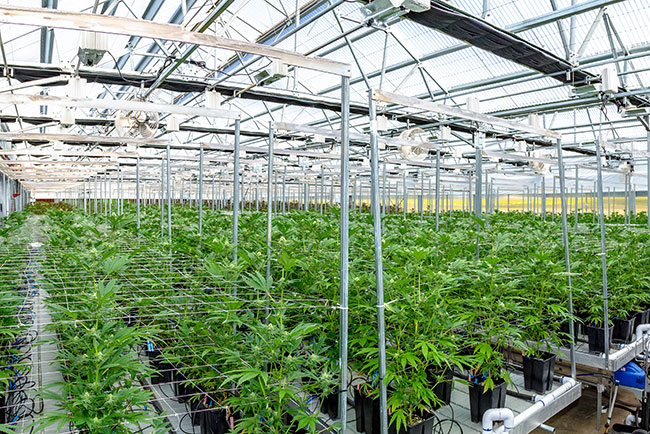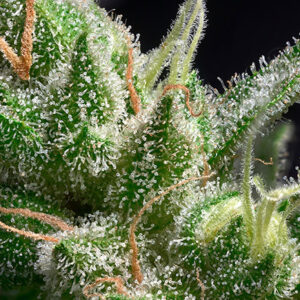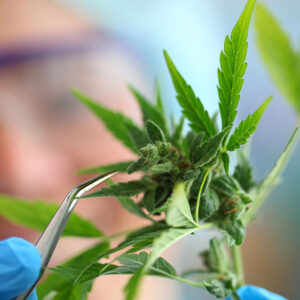
Features
Cannabis
Beyond the strain: Chasing a cultivated high
Good horticultural management is key to growing a cannabis crop high in THC.
February 14, 2022 By Deron Caplan, PhD
 Maintaining good plant health can help the crop produce enough secondary metabolites.
Photo credit: © rabbitholephoto / Adobe Stock
Maintaining good plant health can help the crop produce enough secondary metabolites.
Photo credit: © rabbitholephoto / Adobe Stock As a horticulture consultant specializing in cannabis production, one of the most common questions I get is, “how can we consistently increase THC content?” Unfortunately, my answer is not straightforward, but I’ve done my best to summarize it here. As a disclaimer, the following methods are based on hands-on experience, consultation with experienced cannabis cultivators and recent scientific studies. The research in this area is still quite limited.
If you want to maximize THC content in cannabis inflorescences (buds), cultivar selection is the most important first step. To a certain extent, the cultivar dictates the upper limit of THC expression. For this reason, building relationships with experienced breeders and constantly trialling new cultivars in your facility or new cultivation system is vital.
The next step to growing high-THC cannabis is good horticultural management. Maintaining good plant health throughout the crop ensures that plants can produce enough carbohydrates that can be converted to secondary metabolites like THC, other cannabinoids, and terpenes. Suppose a grower can consistently grow a healthy crop, avoiding common environmental or cultural stressors (described later), then it’s reasonable to assume that THC values will be close to the theoretical maximum of the cultivar. However, it seems likely that some horticultural practices can actually stimulate THC by pushing the plant beyond its optimal health. The research is early, but treatments such as controlled drought stress during the flowering stage have stimulated THC content in some cases.1
The greatest barriers
Of the barriers to growing high THC cannabis, there are several that are key hurdles.
- Inconsistent growing environment: Temperature and humidity impact plant transpiration and nutrient uptake. Environmental set points can be tuned to encourage faster growth rates and maturation, but if managed improperly, this can hasten the onset of water and nutrient deficiencies. Frequent swings in specific environmental parameters can also be troublesome. For example, overly fluctuating humidity can bring on issues with fungal diseases that impact crop health and, consequently, THC content.
- Over-watering: Irrigating too frequently can cause an oxygen-deprived root zone, promoting disease from waterborne pathogens. The key is to allow sufficient dry-down of the growing media between irrigations, especially when water use is low at times close to harvest.
- Harvest Timing: THC accumulates at varying rates depending on the cultivar. Typically, THC levels increase to a maximum at some point during flowering then begin to drop off as it is converted to other minor cannabinoids. By sampling the THC content in your buds throughout the flowering stage, you can identify this maximum to inform harvest timing. I’ve seen THC levels peak anytime from day 40 to day 70 of flowering in an indoor environment.
- Nutrient imbalances: These are commonly caused by sub-optimal fertilizer rates or ratios, growing media pH, or environmental conditions. Make sure to closely monitor the nutrients in leaf tissue and the growing media throughout the crop. Samples can usually be sent to a lab as part of a standard service.
- Analytical testing: This point may seem out of place, but how you sample the buds and where you send them for analysis impacts the THC value going on the package. THC content can vary depending on the location of the bud on the plant or where it was situated in the growing area. Picking representative samples ensures a more meaningful result. There also tends to be variability between labs, so shop around for one that provides consistently accurate results.
The downside of high THC
THC is not the sole indicator of good cannabis.
Back in the 1960s to 1980s, the THC content of cannabis was typically less than two per cent. Since then, cannabis breeders and growers have been pushing THC levels higher and higher to the point where it’s now common to see dry flower with over 20 per cent THC on today’s dispensary shelves.
While the focus has historically been on THC, cannabis trichomes (resin glands) also contain an array of other interesting and desirable compounds. For example, terpenes and other cannabinoids can alter both the physiological effects of a cannabis product and contribute to unique smells and flavours. The plant can only produce so much resin from these trichomes, so when THC levels are high, it can be at the expense of these other compounds.
Doesn’t more THC mean a more intoxicating effect? Not necessarily. A 2020 study from the University of Colorado at Boulder’s Institute of Cognitive Science2 found that the THC content of the cannabis flower was a poor indicator of potency. Sixty-four trial participants consumed dry flower ranging from 16 per cent to 24 per cent THC and reported no difference in intoxication based on THC content. This seems counterintuitive, especially considering that many consumers shop for higher THC products to get the best bang for their buck.
It is apparent that our fixation on THC has decreased the prevalence of other, perhaps more desirable, compounds in cannabis and, therefore, the diversity of the products on the shelf. It’s unfair to expect an immediate shift in demand away from high THC products, but consumers are gradually becoming more experienced and informed. Soon, it might be the terpene content, aroma, or the presence of some minor cannabinoid that drives a purchase. This could mean that growers can stop worrying about whether their next batch is going to hit 20 per cent THC and, instead, focus on unique cultivars and their crop’s other differentiating characteristics.
References
- Caplan D, Dixon M, Zheng Y. Increasing Inflorescence Dry Weight and Cannabinoid Content in Medical Cannabis Using Controlled Drought Stress. HortScience. 2019;54(5):964-969. doi:10.21273/hortsci13510-18
- Bidwell LC, Ellingson JM, Karoly HC, et al. Association of naturalistic administration of cannabis flower and concentrates with intoxication and impairment. JAMA Psychiatry. 2020;77(8):787-796. doi:10.1001/jamapsychiatry.2020.0927
Deron Caplan, PhD, is a horticultural consultant at Sostanza Global. He is based out of British Columbia and can be reached at deron@sostanzaglobal.com.
Print this page

